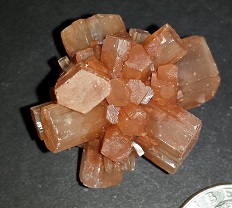A- |
B- |
C- |
D- |
E- |
F- |
G- |
H- |
I- |
J- |
K- |
L- |
M- |
N- |
O- |
P- |
Q- |
R- |
S- |
T- |
U- |
V- |
W- |
X- |
Y- |
Z |
ARAGONITE:PHYSICAL CHARACTERISTICS:Color can be white or colorless or with usually subdued shades of red, yellow, orange, brown, green and even blue. Luster is vitreous to dull. Transparency: Crystals are transparent to translucent. Crystal System is orthorhombic; 2/m 2/m 2/m Crystal Habits include twinned hexagonal prismatic crystals as well as a diverse assortment of thin elongated prismatic, curved bladed, steep pyramidal (spiked) and chisel shaped crystals. A branching tree, coral or worm-like delicate form is called "flos ferri". Can also be compact, granular, radially fibrous and massive. Its massive forms can be layered, coralloid, pisolitic, oolitic, globular, stalachtitic and encrusting. Aragonite is a constituent of many species' shell structures. A layered sedimentary marble like formation is called Mexican Onyx and is used for carvings and ornamental purposes. Calcite pseudomorphs of aragonite crystals and formations are common. Cleavage is distinct in one direction (pinacoidal). Hardness is 3.5-4 Streak is white. Other Characteristics: aragonite effervesces easily in cold dilute hydrochloric acid, is strongly birefringent, is fluorescent and its refractive index is 1.7. Associated Minerals include gypsum, barite, smithsonite, malachite, calcite, serpentine, sulfur, celestite, zeolites, quartz, clays, dolomite, limonite, chalcopyrite and wulfenite among many others. Notable Occurrences include Aragon, Spain (its type locality and from where it gets its name); Morocco; Bastennes, France; Girgenti, Sicily; Alston Moor and Cleator Moor, Cumberland, England; Baja California, Mexico (Mexican Onyx); Tsumeb, Namibia; Carinthia, Austria; Leadhills, Scotland; Harz Mountains, Germany and in several localities in the Southwestern United States. Best Field Indicators are crystal habits, single plane of cleavage and reaction to acid. Aragonite is a common carbonate mineral. It is unfortunately often thought of as the poor cousin to calcite. But aragonite is an interesting and attractive mineral in its own right. It forms interesting habits and can have a soft pretty color. Its modes of formation and relationship to calcite are both curious and intriguing. Aragonite is a polymorph of calcite, which means that it has the same chemistry as calcite but it has a different structure, and more importantly, different symmetry and crystal shapes. Aragonite's more compact structure is composed of triangular carbonate ion groups (CO3), with a carbon at the center of the triangle and the three oxygens at each corner. Unlike in calcite, the carbonate ions do not lie in a single plane pointing in the same direction. Instead they lie in two planes that point in opposite directions; destroying the trigonal symmetry that is characteristic of calcite's structure. To illustrate this, imagine the symmetry of an equilateral triangle; a three fold rotation with three mirror planes that cross in the center. Now join two of these triangles together at their bases and you have a diamond-shaped figure with the symmetry of a two fold rotation with one mirror plane in the middle. This is what the effect of the two carbonate planes with opposite orientations has on the symmetry of this structure. Aragonite has an orthorhombic symmetry (2/m 2/m 2/m) instead of calcite's "higher" trigonal (bar 3 2/m) symmetry. A very rare mineral called vaterite is also a polymorph of aragonite and calcite; making them all trimorphs. Vaterite has an hexagonal symmetry (6/m 2/m 2/m). |

